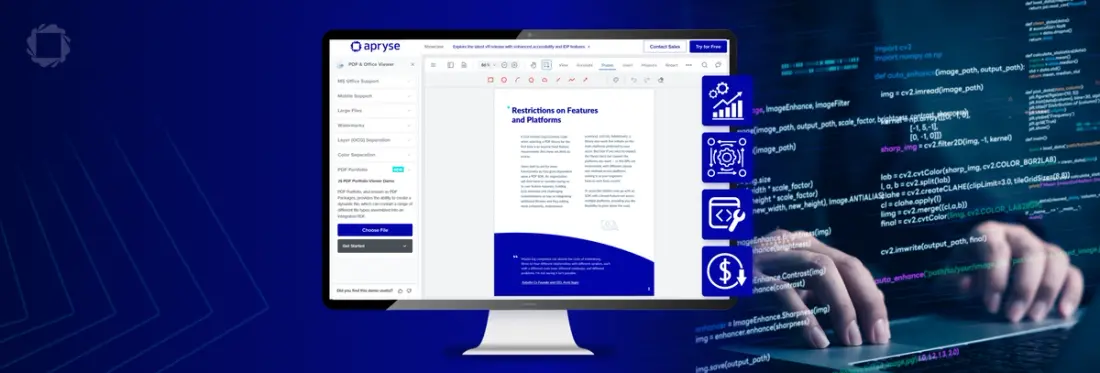A Developer’s Guide to Reducing Dependencies
By Isaac Maw | 2025 Apr 11

5 min
Tags
PDF SDK
Vendor consolidation
Today, most software development projects begin with capital investment, headcount, and ambitious goals. Development includes a variety of third-party resources, including SDKs, open-source libraries, third-party tools, and maybe even a few snippets of code from StackOverflow.
But when the sprints, stories and standups are done, the capital investment has tapered off, and your development team has seen turnover and personnel changes, your project may be left with a fragmented, chaotic tangle of dependencies, licenses, and redundancies.
Common situations we’ve heard from our customers that have dealt with vendor consolidation include:
Fragmented Modules and Licensing Chaos: After several acquisitions, the tech stack was a patchwork of fragmented SDKs and an inconsistent licensing structure. Managing multiple solutions became a significant burden, with overlapping product capabilities driving up maintenance costs and creating inefficiencies. The team was determined to consolidate their tools to regain control, simplify licensing, and reduce unnecessary expenses.
Costly Compliance Challenges: Every three years, faced with a daunting task: re-evaluating and updating their forms to align with ever-evolving regulations. This process consumed significant developer time, driving up costs and stretching resources thin. They needed a streamlined, efficient way to ensure document compliance without derailing their development roadmap or overburdening their team.
Overlapping Tools Hindering Efficiency: While developing a new feature requiring advanced template generation, they realized their reliance on multiple vendors was redundant. As longtime Aspose users, they appreciated the tool but found Apryse’s robust server-side document manipulation capabilities a compelling alternative. Consolidating these functions with Apryse allowed them to eliminate overlap, reduce complexity, and simplify their tech stack—all while unlocking better performance and functionality.
In this blog, we’ll tackle the issues surrounding fragmented SDK vendors, and how to begin implementing a consolidated strategy.
To learn more about tackling these tech challenges with vendor consolidation strategies, get the whitepaper.
Best Practices for Integrating Third-Party Code into Your App
SDKs are a necessary and valuable part of software development, but to ensure your application remains future-proof and flexible enough to consolidate vendors in the future or change tools if needed, consider these best practices:
Evaluate SDKs Thoroughly
Before integrating any third-party toolkit, conduct a comprehensive evaluation. Assess the vendor and product’s reliability, performance, and security. Check for regular updates and active support from the vendor. Read reviews and seek feedback from other developers who have used the SDK. This due diligence helps avoid potential issues down the line.
Plan for the Future
When selecting SDKs, consider the possibility of consolidating vendors in the future.
Often, devs select best-of-breed or well-known SDKs, but in some situations selecting other options that align with other SDKs already in place can help avoid compatibility issues and bloat. Choose SDKs from vendors that offer a broad range of services and have a strong reputation in the industry. This approach simplifies vendor management and reduces the complexity of your application's architecture.
Abstract SDK Implementations
This is a key step, and it’s something most developers already know. Creating an abstraction layer between your application code and the SDK allows you to swap out SDKs with minimal changes to your core application logic. Use interfaces or adapter patterns to define the interactions with the SDK, making it easier to replace or update the SDK in the future.
Keep Dependencies Minimal
While SDKs can add valuable features, they also introduce dependencies. Keep these dependencies to a minimum to reduce the risk of conflicts and compatibility issues. Avoid integrating multiple SDKs that serve similar purposes. Instead, choose the most versatile and reliable option that meets your needs.
One situation that can lead to dependency issues is when two apps or products are merged into one offering, such as when one company purchases another and makes the acquired company’s products into features of their original product. Reviewing dependencies including versions can help mitigate these integration problems.
Stay Updated
Vendors frequently release updates that include new features, bug fixes, and security patches. Stay updated with the latest versions to ensure your application benefits from these improvements.
Document SDK Integrations
Maintain detailed documentation of all integrations. Document the purpose of each SDK, how it is integrated, and any custom configurations or modifications. This documentation is invaluable for future developers who may need to update or replace the SDK. It also helps in troubleshooting any issues that arise.
Implement Robust Testing
Implement comprehensive testing for all integrations. Use unit tests, integration tests, and end-to-end tests to ensure third-party solutions function correctly within your application. Automated testing can help quickly identify issues when updating versions or making changes to your application.
Benefits of Vendor Consolidation
Reducing dependencies can help realize the following benefits:
- Cost Savings: Eliminate redundant tools, cut unused licenses, and focus resources on high-value solutions.
- Increased Efficiency: Streamlined workflows lower maintenance costs and reduce the risks of siloed data.
- Developer Tooling Simplification: Developers face compatibility issues and steep learning curves when using disparate SDKs and APIs. Consolidation could help faster development cycles, and reduced onboarding times.
- Strategic Alignment: Ensure IT tools align with enterprise goals to maximize utility and long-term value.
Conclusion
Developing functionality, such as a variety of document processing features, can often result in a long list of third-party dependencies. Because managing all these dependencies can become a problem, many leaders are considering SDK vendor consolidation to achieve the required functionality with a simplified tech stack.
If you’re ready to take steps toward streamlining your dependencies, contact our sales team.
Tags
PDF SDK
Vendor consolidation

Isaac Maw
Technical Content Creator
Share this post


